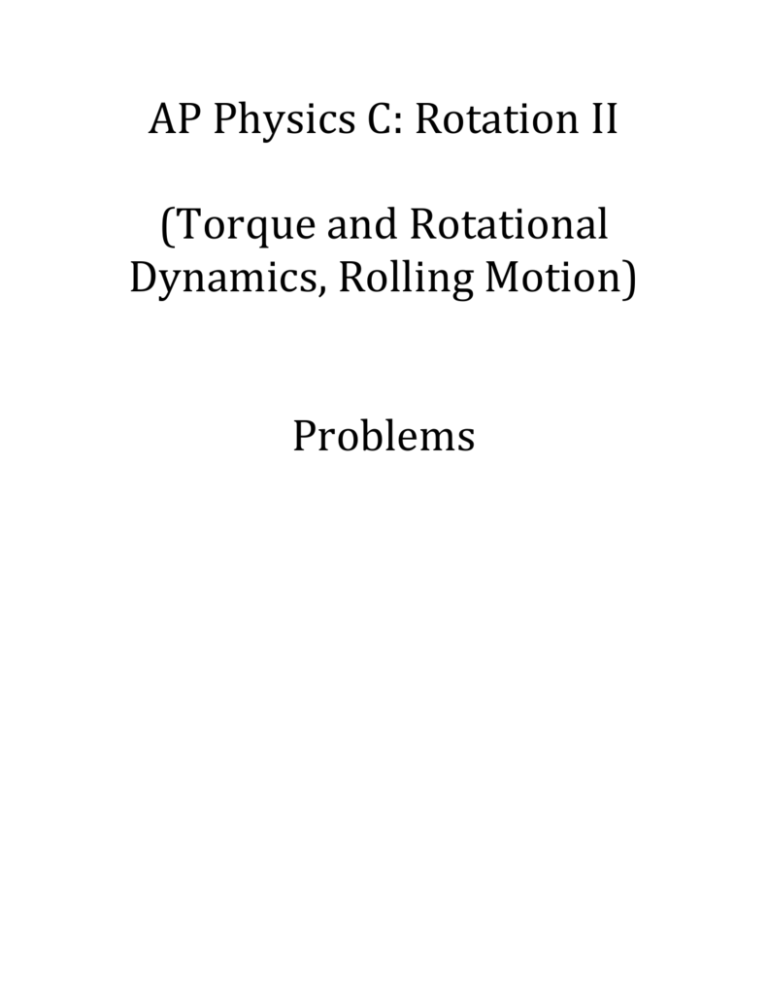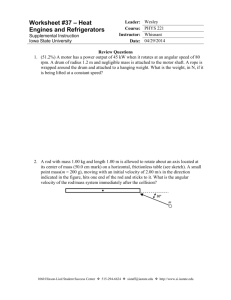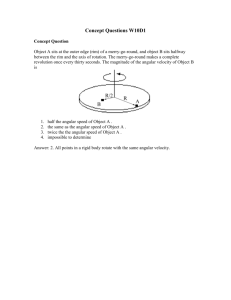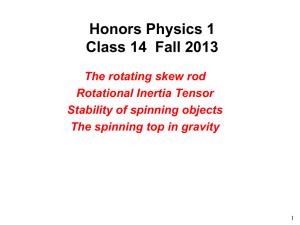Rotation II Problems - stjohns
advertisement

AP Physics C: Rotation II (Torque and Rotational Dynamics, Rolling Motion) Problems 1980M3. A billiard ball has mass M, radius R, and moment of inertia about the center of mass I c = 2 MR²/5 The ball is struck by a cue stick along a horizontal line through the ball's center of mass so that the ball initially slides with a velocity vo as shown above. As the ball moves across the rough billiard table (coefficient of sliding friction k), its motion gradually changes from pure translation through rolling with slipping to rolling without slipping. a. Develop an expression for the linear velocity v of the center of the ball as a function of time while it is rolling with slipping. b. Develop an expression for the angular velocity of the ball as a function of time while it is rolling with slipping. c. Determine the time at which the ball begins to roll without slipping. d. When the ball is struck it acquires an angular momentum about the fixed point P on the surface of the table. During the subsequent motion the angular momentum about point P remains constant despite the frictional force. Explain why this is so. 1981M3. A thin, uniform rod of mass M 1 and length L , is initially at rest on a frictionless horizontal surface. The moment of inertia of the rod about its center of mass is M 1L2/12. As shown in Figure I, the rod is struck at point P by a mass m2 whose initial velocity v is perpendicular to the rod. After the collision, mass m2 has velocity -½v as shown in Figure II. Answer the following in terms of the symbols given. a. Using the principle of conservation of linear momentum, determine the velocity v’ of the center of mass of this rod after the collision. b. Using the principle of conservation of angular momentum, determine the angular velocity of the rod about its center of mass after the collision. c. Determine the change in kinetic energy of the system resulting from the collision. 1982M3. A system consists of two small disks, of masses m and 2m, attached to a rod of negligible mass of length 3l as shown above. The rod is free to turn about a vertical axis through point P. The two disks rest on a rough horizontal surface; the coefficient of friction between the disks and the surface is . At time t = 0, the rod has an initial counterclockwise angular velocity o about P. The system is gradually brought to rest by friction. Develop expressions for the following quantities in terms of m, l, g, and o a. The initial angular momentum of the system about the axis through P b. The frictional torque acting on the system about the axis through P c. The time T at which the system will come to rest. 1983M2. A uniform solid cylinder of mass m1 and radius R is mounted on frictionless bearings about a fixed axis through O. The moment of inertia of the cylinder about the axis is I = ½m1R2. A block of mass m2, suspended by a cord wrapped around the cylinder as shown above, is released at time t = 0. a. On the diagram below draw and identify all of the forces acting on the cylinder and on the block. b. In terms of ml, m2, R. and g, determine each of the following. i. The acceleration of the block ii. The tension in the cord iii. The angular momentum of the disk as a function of time t. 1985M3. A pulley of mass 3m and radius r is mounted on frictionless bearings and supported by a stand of mass 4m at rest on a table as shown above. The moment of inertia of this pulley about its axis is 1.5mr 2. Passing over the pulley is a massless cord supporting a block of mass m on the left and a block of mass 2m on the right. The cord does not slip on the pulley, so after the block-pulley system is released from rest, the pulley begins to rotate. a. On the diagrams below, draw and label all the forces acting on each block. b. Use the symbols identified in part (a) to write each of the following. i. The equations of translational motion (Newton's second law) for each of the two blocks ii. The analogous equation for the rotational motion of the pulley c. Solve the equations in part (b) for the acceleration of the two blocks. d. Determine the tension in the segment of the cord attached to the block of mass m. e. Determine the normal force exerted on the apparatus by the table while the blocks are in motion. 1986M2. An inclined plane makes an angle of with the horizontal, as shown above. A solid sphere of radius R and mass M is initially at rest in the position shown, such that the lowest point of the sphere is a vertical height h above the base of the plane. The sphere is released and rolls down the plane without slipping. The moment of inertia of the sphere about an axis through its center is 2MR2/5. Express your answers in terms of M, R. h, g, and B. a. Determine the following for the sphere when it is at the bottom of the plane: i. Its translational kinetic energy ii. Its rotational kinetic energy b. Determine the following for the sphere when it is on the plane. i. Its linear acceleration ii. The magnitude of the frictional force acting on it The solid sphere is replaced by a hollow sphere of identical radius R and mass M. The hollow sphere, which is released from the same location as the solid sphere, rolls down the incline without slipping. c. What is the total kinetic energy of the hollow sphere at the bottom of the plane? d. State whether the rotational kinetic energy of the hollow sphere is greater than, less than, or equal to that of the solid sphere at the bottom of the plane. Justify your answer. 1988M3. The two uniform disks shown above have equal mass, and each can rotate on frictionless bearings about a fixed axis through its center. The smaller disk has a radius R and moment of inertia I about its axis. The larger disk has a radius 2R a. Determine the moment of inertia of the larger disk about its axis in terms of I. The two disks are then linked as shown below by a light chain that cannot slip. They are at rest when, at time t = 0, a student applies a torque to the smaller disk, and it rotates counterclockwise with constant angular acceleration . Assume that the mass of the chain and the tension in the lower part of the chain, are negligible. In terms of I, R, , and t, determine each of the following: b. The angular acceleration of the larger disk c. The tension in the upper part of the chain d. The torque that the student applied to the smaller disk e. The rotational kinetic energy of the smaller disk as a function of time 1992M2. Two identical spheres, each of mass M and negligible radius, are fastened to opposite ends of a rod of negligible mass and length 2l. This system is initially at rest with the rod horizontal, as shown above, and is free to rotate about a frictionless, horizontal axis through the center of the rod and perpendicular to the plane of the page. A bug, of mass 3M, lands gently on the sphere on the left. Assume that the size of the bug is small compared to the length of the rod. Express your answers to all parts of the question in terms of M, l, and physical constants. a. Determine the torque about the axis immediately after the bug lands on the sphere. b. Determine the angular acceleration of the rod-spheres-bug system immediately after the bug lands. The rod-spheres-bug system swings about the axis. At the instant that the rod is vertical, as shown above, determine each of the following. c. The angular speed of the bug d. The angular momentum of the system e. The magnitude and direction of the force that must be exerted on the bug by the sphere to keep the bug from being thrown off the sphere 1996M3. Consider a thin uniform rod of mass M and length l, as shown above. a. Show that the rotational inertia of the rod about an axis through its center and perpendicular to its length is Ml2/12 . The rod is now glued to a thin hoop of mass M and radius R/2 to form a rigid assembly, as shown above. The centers of the rod and the hoop coincide at point P. The assembly is mounted on a horizontal axle through point P and perpendicular to the page. b. What is the rotational inertia of the rod-hoop assembly about the axle? Several turns of string are wrapped tightly around the circumference of the hoop. The system is at rest when a cat, also of mass M, grabs the free end of the string and hangs vertically from it without swinging as it unwinds, causing the rod-hoop assembly to rotate. Neglect friction and the mass of the string. c. Determine the tension T in the string. d. Determine the angular acceleration a of the rod-hoop assembly. e. Determine the linear acceleration of the cat. f. After descending a distance H = 5l/3, the cat lets go of the string. At that instant, what is the angular momentum of the cat about point P ? 1998M2. A space shuttle astronaut in a circular orbit around the Earth has an assembly consisting of two small dense spheres, each of mass m, whose centers are connected by a rigid rod of length l and negligible mass. The astronaut also has a device that will launch a small lump of clay of mass m at speed v0 . Express your answers in terms of m, v0 l. and fundamental constants. a. Initially, the assembly is "floating" freely at rest relative to the cabin, and the astronaut launches the clay lump so that it perpendicularly strikes and sticks to the midpoint of the rod, as shown above. i. Determine the total kinetic energy of the system (assembly and clay lump) after the collision. ii. Determine the change in kinetic energy as a result of the collision. b. The assembly is brought to rest, the clay lump removed, and the experiment is repeated as shown above, with the clay lump striking perpendicular to the rod but this time sticking to one of the spheres of the assembly. i. Determine the distance from the left end of the rod to the center of mass of the system (assembly and clay lump) immediately after the collision. (Assume that the radii of the spheres and clay lump are much smaller than the separation of the spheres.) ii. On the figure above, indicate the direction of the motion of the center of mass immediately after the collision. iii. Determine the speed of the center of mass immediately after the collision. iv. Determine the angular speed of the system (assembly and clay lump) immediately after the collision. v. Determine the change in kinetic energy as a result of the collision. 1997M3. A solid cylinder with mass M, radius R, and rotational inertia ½MR 2 rolls without slipping down the inclined plane shown above. The cylinder starts from rest at a height H. The inclined plane makes an angle with the horizontal. Express all solutions in terms of M, R, H, , and g. a. Determine the translational speed of the cylinder when it reaches the bottom of the inclined plane. b. On the figure below, draw and label the forces acting on the cylinder as it rolls down the inclined plane Your arrow should begin at the point of application of each force. c. Show that the acceleration of the center of mass of the cylinder while it is rolling down the inclined plane is (2/3)g sin. d. Determine the minimum coefficient of friction between the cylinder and the inclined plane that is required for the cylinder to roll without slipping. e. The coefficient of friction is now made less than the value determined in part (d), so that the cylinder both rotates and slips. i. Indicate whether the translational speed of the cylinder at the bottom of the inclined plane is greater than, less than, or equal to the translational speed calculated in part (a). Justify your answer. ii. Indicate whether the total kinetic energy of the cylinder at the bottom of the inclined plane is greater than, less than, or equal to the total kinetic energy for the previous case of rolling without slipping. Justify your answer.








